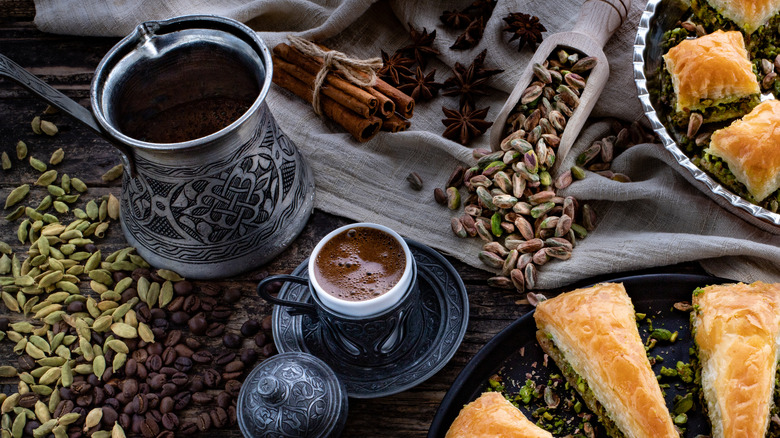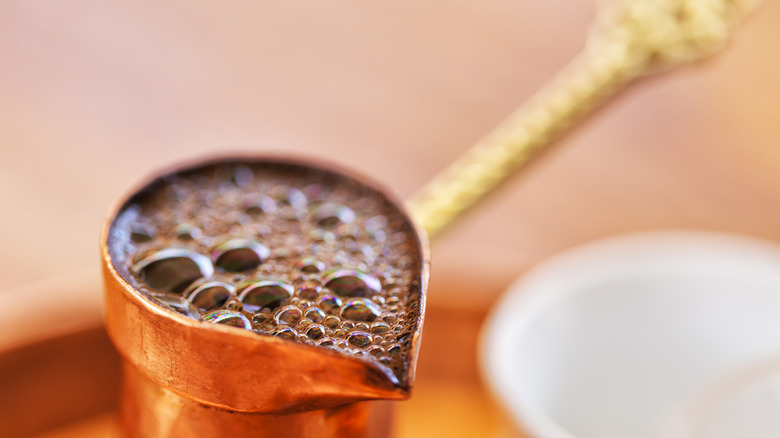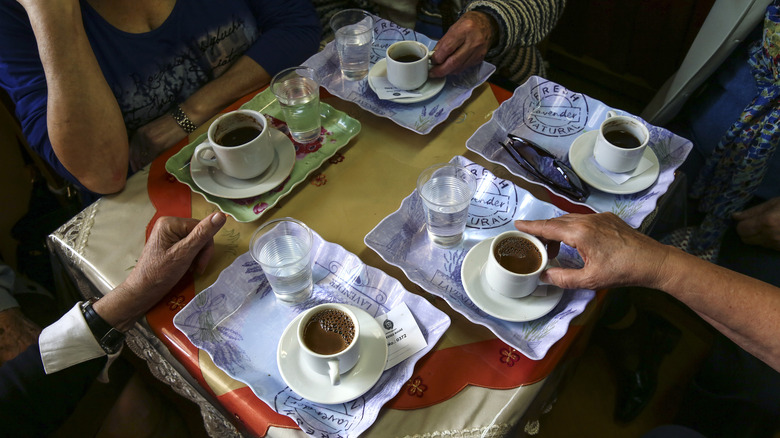The Brewing Method That Makes Greek Coffee Unique
If you've had the pleasure of living in or visiting Greece, you know foods like feta, olives, baklava, and tzatziki play a key role in the country's agriculture, heritage, and customs. But there's another culinary tradition that's just as essential to everyday life: coffee. Similar to Turkish coffee and other coffee-making methods in nearby regions, the Greek style is known for its thick, creamy texture with a quintessential foam top.
What makes every luxurious cup of Greek coffee (Elleniko Kafe) unique is a slow-boiling method conducted in a special pot called a briki. Commonly made out of brass or copper with a long handle (though there are now electric versions), the pot is used to gently boil water and finely ground Arabica beans together until the coffee gets its signature creamy texture with a layer of bubbly foam (referred to as kaïmaki). Sugar is often added to the mix, too, before it's all slowly heated.
The strength of a cup of Greek coffee is similar to other bold coffees like espresso, but making it doesn't involve the mechanics of pressure or filtration required in other coffees and regional styles. After slowly boiling the coffee in a briki until the optimal flavor and foam are developed, Greek coffee is served simply in small demitasse cups (similar to espresso cups), coffee grounds and all. The fine grounds are then left to settle to the bottom of the cup, and the coffee is traditionally savored — slowly, just like its low heating process.
The coffee is heated on low for optimal flavor and creating foam
Making a cup of Greek coffee requires a briki, quality coffee (preferably from the country) ground into a fine powder, and some attention to detail. If you have demitasse cups on hand, it's common to simply measure 2 to 3 ounces of water right in the cup before pouring it in the pot. For optimal foam development make sure to use cold water, then add coffee grounds in by the teaspoon, along with any sugar. It's recommended just to give the mixture a stir to incorporate, then leave it be as it heats gently.
Greek coffee's signature froth is created by bringing the coffee to a low boil. You don't want to let it reach a vigorous, full boil, or else the thick, bubbly layer on top with actually subside. Instead, once some bubbles start to form, it's customary to remove the pot from the heat to avoid boiling over as the coffee brews into a flavorful, velvety liquid. Then, the briki full of coffee is added back onto the heat source and allowed to bubble and foam again, before removing it and serving. This preserves the foam at the top of the pot, so it gets transferred to the coffee cup. If using a larger briki for multiple cups of coffee, it's key to dollop some foam into each cup before pouring in the coffee to equally distribute the bubbly portion.
How to enjoy Greek coffee
Greek coffee is typically served simply alongside a glass of cold water. On special occasions, the coffee is also served with cookies like koulourakia (Greek butter cookies) — which are great for dunking. The coffee is usually served black (sketos) or with sugar, and it is less common to have it with milk than other coffee styles and preparations. For a cup with balanced sweet and bold qualities, Greek coffee can be prepared "metrios" — with 1 teaspoon sugar per 1 teaspoon coffee. Or it can be made sweeter with an extra teaspoon of sugar (glykos) or 3 teaspoons of sugar for every 2 teaspoons coffee (variglycos).
Since Greek coffee is gently boiled to develop the flavor and foam, then served with the grounds in the cup, it's also important to wait for the grounds to sink before taking your first sip of coffee. This is generally no problem, since locals in Greece have been known to enjoy their coffee and socialize for an hour or two at a time, often until late in the day. Though there are many different types of coffee, it's usually best to enjoy a cup with company — and people from Greece know this well. If you get the chance to try Greek coffee or make it on your own in a briki, take a page from the traditional way and enjoy your coffee luxuriously and slowly, as it was meant to be.


